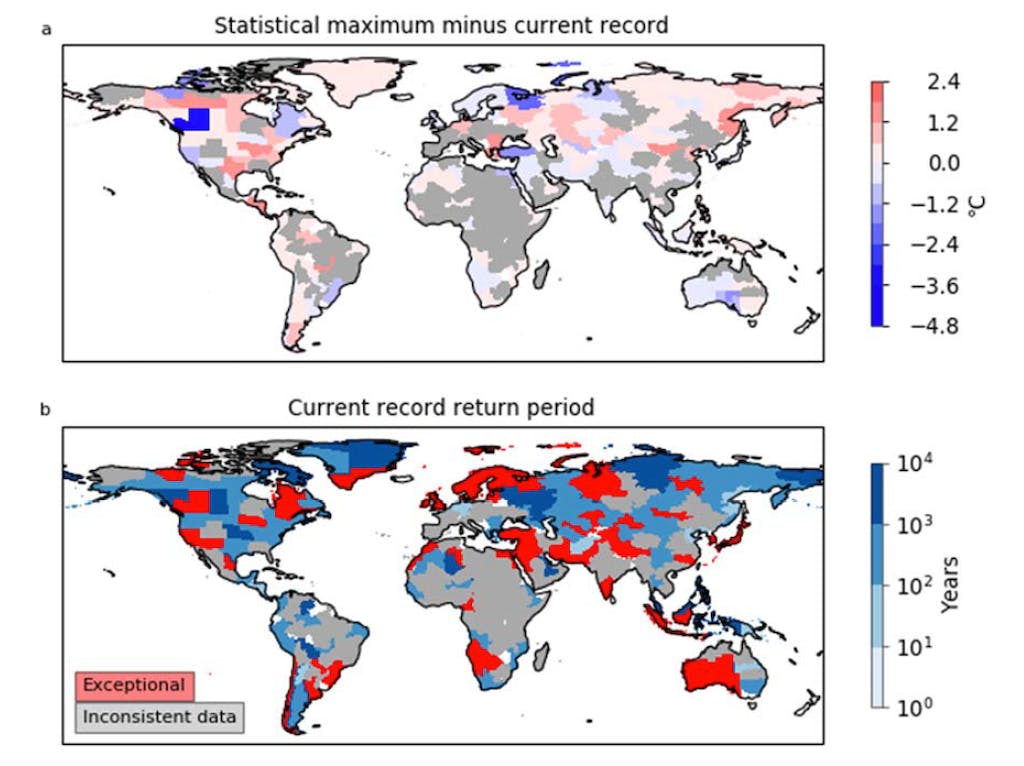Climate change is driving a rise in “record-shattering” heatwaves that break existing temperature records by unprecedented margins. The 2021 Pacific north-west heatwave – which broke long-standing temperature records across much of the US and Canada by as much as 5C – is a clear example.
New research, published in Nature Communications, finds that 41 regions around the world have experienced “statistically implausible” heat since 1959 – accounting for 31 per cent of the planet’s surface. “It appears that such extremes could occur anywhere and at any time,” the paper says.
Some regions – including eastern Russia, Central America, Afghanistan and Papua New Guinea – have been “lucky” to not have seen such extreme temperatures over this time, the paper says. However, there is a downside to this luck.
The authors explain that regions which have not seen exceptional heat events recently “have had no need to adapt to such events, and so may be more susceptible to the[ir] impacts”. Afghanistan and Papua New Guinea are particularly at risk thanks to their growing populations and limited healthcare and energy resources, the paper says.
The research highlights the importance of adapting to heatwaves more extreme than those seen so far. “Heatwaves are deadly – but better preparation can save lives,” the study concludes.
Record-shattering heat
The June 2021 Pacific north-west heat dome is one of the most extreme heat events on record. During the heatwave, the Canadian village of Lytton recorded temperatures of 46.1C, 47.9C and 49.6C on three consecutive days, shattering the region’s previous record of 45C.
The impacts were widespread and deadly. Wildfires raged, crops wilted and railways buckled. Schools and businesses closed, while buildings with air-conditioning such as libraries, cinemas and shopping malls opened up to the public as emergency “cooling shelters”. Despite these precautions, hundreds of people died due to heat-related illnesses across Canada and the US.
The Pacific north-west heatwave attracted widespread media attention, and has been the subject of extensive further study. A rapid attribution study says the event would have been “virtually impossible” without human-caused global warming. It warns that a “rapidly warming climate is bringing us into uncharted territory with significant consequences for health, well-being and livelihoods”.
“
The poorest quarter of the world population is projected to experience as much heatwave exposure as the other three quarters combined by the end of the century.
Prof Mojtaba Sadegh, assistant professor, Boise State University
Dr Erich Fischer – a lecturer from ETH Zurich, who was not involved in the study – has published separate research warning that “record-shattering” extremes, such as the 2021 heatwave, are becoming more frequent as the climate warms.
He tells Carbon Brief that many other regions around the world have also experienced record-shattering extremes – including the record-warm 2023 New Year’s warm spell in Europe, the record warm 2022 summer in China, the first exceedance of 40C in the UK, record glacier melt rates in the Alps in 2022, and the 2020 persistent Siberian heatwave.
‘Exceptional’ extremes
The new study uses a method called “extreme value theory” to put the 2021 Pacific northwest heatwave into its historical context. The authors use a 62-year temperature record to determine the statistical likelihood of heatwaves of different intensities in Alberta, Canada.
Before the unprecedented 2021 heatwave, Alberta’s hottest year on record was in 2018. The authors find that this heatwave had a return period of 166 years, meaning that a heatwave of that magnitude would be expected to occur once within a 166 year period.
By contrast, the 2021 heatwave exceeded the “statistical maximum” return period of 10,000 years, meaning that based on the historical record of past heat events alone, the heatwave was “statistically implausible”. The authors call this heatwave “exceptional”.
To identify other exceptional heat events, the study authors calculate the temperature of one-in-10,000-year heat events in different regions. They then determine the return period of each region’s current record temperature. If the return period of a region’s current record-high temperature is higher than the temperature of its one-in-10,000 event, then they say the record-high temperature was “exceptional”.
These results are shown on the maps below. The top map shows the 1-in-10,000-year temperature minus the current record temperature. Blue shading indicates that the region has experienced “exceptional” heat in the past 62 years, while red indicates that it has not.
The bottom map shows the return period for each region’s current heat record, where darker blue indicates a longer return period. Red shading indicates an “exceptional” event, with a return period higher than 10,000 years. Grey indicates that data was not available for this region.

The 1-in-10,000-year temperature minus the current record temperature (top) and return period for each heat record (bottom). An “exceptional” event is defined as one with a return period higher than 10,000 years. Source: Thompson et al (2023).
The authors find that 41 of the 136 regions analysed have experienced exceptional heat since 1959. These regions are spread across the globe with no apparent pattern, according to the study, which says “it appears that such extremes could occur anywhere and at any time”.
However, the authors find that exceptional events have been getting more frequent as time goes on. They suggest that this is due to both the greater availability of satellite data in more recent years and the rise in background temperature driven by climate change.
Fischer tells Carbon Brief that the study is “rigorous and very relevant”, and demonstrates that it is “very challenging to quantify the most intense extremes possible”. He adds that the paper “reveals shortcomings of widely used statistical approaches and calls for a major community effort to refine our understanding and quantification of plausible worst-case storylines for extreme events of the coming decades”.
Unprepared
The impacts of extreme heat are wide-ranging and deadly, but governments and individuals can take steps to limit the damage.
For example, the study says “city heat plans that include actions such as establishing cooling centres or reducing hours of work for outdoor workers can reduce heat impacts”.
In the aftermath of a heatwave, regions often adopt measures to increase their resilience. This can reduce the impacts of the next extreme event, the study says:
“Policy changes following the 2003 European heatwave led to fewer deaths after the similar magnitude 2006 event and humanitarian response plans in Bangladesh reduced mortality from Cyclone Amphan in 2020.”
However, the authors also warn that “countries tend to prepare to the level of the greatest event they have experienced within collective memory”.
Dr Thomas McDermott – a foundation lecturer at the University of Galway who researches the economics of climate change and extreme weather, and was not involved in the study – agrees with this warning. He explains that official risk assessments are often “backward looking” and “adaptation efforts tend to follow from the experience of extreme events”.
Dr Luke Harrington is a senior lecturer at the University of Waikato and was also not involved in the study. He tells Carbon Brief that backward-looking adaptation measures mean “places which have so far been statistically ‘lucky’ and not yet experienced a significant event will be less prepared when that record-breaking event inevitably arrives”.
To assess a region’s preparedness for its next record-breaking heatwave, the authors calculate the temperature of a one-in-100-year heat extreme in the region. Prof Dann Mitchell – a professor of climate science at the University of Bristol and an author on the study – tells Carbon Brief that this magnitude of event was picked because it is “a good timescale for a person’s lifetime”.
They then determine how close this is to the region’s current record temperature. They classify regions whose current temperature record is well below the one-in-100-year heat extreme as “at risk”.
Regions that are statistically most at risk of a record heatwave are shown in the table below.
In order, the columns indicate the region, the return period of its current record heatwave, its current record temperature, the temperature of a one-in-100-year event, the difference between the current record temperature and the one-in-100-year event, the current population and the expected population growth by 2050. Developing countries and “noteworthy” numbers are shown in bold.

Table showing, from left to right: Region, the return period of its current record heatwave, its current record temperature, the temperature of a 1-in-100 year event, the difference between the record temperature and the 1-in-100 year event, the current population and the projected population growth by 2050 using SSP5. Credit: Thompson et al (2023).
The authors find that eastern Russia, Central America and Afghanistan are the most at risk from record-breaking heat.
Mitchell clarifies that these regions are not “overdue” for a record-breaking heatwave. Instead, he tells Carbon Brief that any heatwave that does hit these regions will have a larger impact, because people are likely to be “less prepared”.
Vulnerability
Three of the eight regions most at risk from record-breaking heat are in developing countries, the study finds.
The authors say Afghanistan is “the region of most concern”, because it is “one of the least developed countries globally” and has “steep population growth” projected for the coming decades.
The paper warns that poorer countries are less likely to have adequate heat action plans and infrastructure in place to deal with extreme heat than their richer counterparts. It adds that population growth can increase the pressure on health services and energy supply.
Prof Mojtaba Sadegh is an assistant professor at Boise State University. He has co-authored research showing that, globally, the lowest-income quarter of the population has already seen 40 per cent more exposure to heatwaves than those in the wealthiest quartile.
Sadegh, who was not involved in the new study, tells Carbon Brief:
“This inequality gap is projected to increase in a warming climate, and if we take into account the adaptation capacity of communities, the poorest quarter of the world population is projected to experience as much heatwave exposure as the other three quarters combined by the end of the century.”
Mitchell tells Carbon Brief that the 2021 Pacific north-west heatwave is an “interesting” case study for extreme heat because the region is “extremely rich”, relative to the global average. Although the impacts of the heatwave were severe, ranging from fires to biodiversity damage, he explains that the impacts on human health were “not very high”.
However, he says this would not be the case for poorer regions. He adds that climate change is “just one of many crises we’re facing” and says that “developing countries really struggle when there’s more than one crisis”.
Lynée Turek-Hankins – a doctoral student at the University of Miami’s Abess Center for Ecosystem Science and Policy, who was not involved in the research – tells Carbon Brief that “low-wealth and developing nations” in particular are “over-reliant on reactive, coping strategies”.
She says this study “raises the stakes for proactive heat adaptation”, but adds that “addressing the factors that make someone more susceptible to heat-related health impacts – such as poor housing quality or social isolation – are worthwhile endeavours even without a heatwave”.
“It is urgent that all governments and people globally take action to reduce the impacts of extreme events,” Sadegh tells Carbon Brief. He adds that “it is upon the wealthy to help poor communities adapt to the new climate”.








